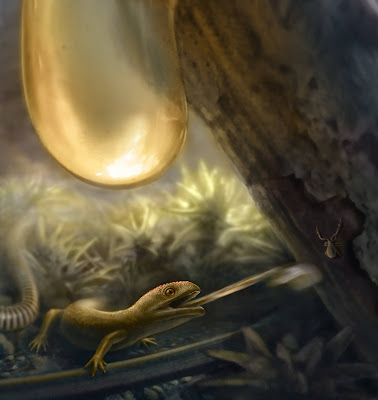The early evolution of diapsid reptiles is marked by a deep contrast between our knowledge of the origin and early evolution of archosauromorphs (crocodiles, avian and non-avian dinosaurs) to that of lepidosauromorphs (squamates (lizards, snakes) and sphenodontians (tuataras)). Whereas the former include hundreds of fossil species across various lineages during the Triassic period1, the latter are represented by an extremely patchy early fossil record comprising only a handful of fragmentary fossils, most of which have uncertain phylogenetic affinities and are confined to Europe. Leer más.





Albanerpetontids are tiny, enigmatic fossil amphibians with a distinctive suite of characteristics, including scales and specialized jaw and neck joints. Here we describe a new genus and species of albanerpetontid, represented by fully articulated and three-dimensional specimens preserved in amber. These specimens preserve skeletal and soft tissues, including an elongated median hyoid element, the tip of which remains embedded in a distal tongue pad. Leer más.

El biólogo Roberto García-Roa examinó una serpiente albina que habían encontrado muerta en el margen de una carretera de un pueblo de Valencia. La muerte del ofidio no se debió a un atropello, sino a una causa biológica muy singular. Leer más.

Aristóteles y, siglos más tarde, Plinio el Viejo, afirmaban que la naturaleza de la salamandra era tan sumamente fría que apagaba el fuego solo con entrar en contacto con él. Tiempo adelante, Isidoro de Sevilla subiría la apuesta, asegurando que este anfibio urodelo “es capaz de emponzoñar y secar un árbol frutal y de envenenar los pozos de agua potable”. Leer más.

We describe a new species of Pristimantis from southern Ecuador, province of Zamora Chinchipe. The new species is closely related to an undescribed species of Pristimantis from Reserva Tapichalaca, Ecuador and with species of a clade historically assigned to the P. unistrigatus species group, such as P. parvillus, P. luteolateralis, P. walkeri, among others. Leer más.








